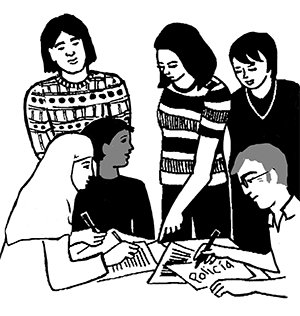A press release is a brief document (no more than one page or 300 words) to bring an event or issue to their attention.
The purpose of a press release (sometimes called news release or media release) is to inspire a journalist to research the story further and/or conduct an interview to write a unique news story.
Remember that reporters, editors and producers are hungry for news, and depend on press releases to tip them off to new events and happenings.

Writing Your Release
Use an active headline to grab the reporter’s attention.
The headline makes your release stand out. Keep it short, active and descriptive; in other words, use something like, “child care cuts mean huge job loss” instead of “city changes child care subsidy criteria”.
Speak From Facts and Experience
Make a list of fact. Be accurate. Check your facts. But also speak from your own experience. Remember you know more than the reporter.
Put the Most Important Information at the Beginning
This is a tried and true rule of journalism. The reporter should be able to tell what the release is about from the first couple of sentences. In fact, chances are that’s all they may read. So don’t hide the good information. And remember the “5 Ws and the H”: make sure your release provides answers to the Who, What, Where, When, Why and How.
Be Active and to the Point
Use language that will get the reader as excited about your news as you are. Use quotes from community members, high profile people or someone involved in the event/action. Quotes help tell your story. If your release is boring or unclear and full of descriptive words, the reporter may assume you will not be good to interview.
Talk to the Reader, Not Yourself
Give details of the news so the editor understands why it’s important to her readers. Tell the story from the perspective of the community affected (people), not a specific agency.
Keep Jargon to the Minimum
Reporters are not as knowledgeable about the issue and your community as you. Make sure you are using clear and simple language, not jargon. Everyday words work best. Avoid acronyms. For example: say “early childhood educator” and not” ECE”.
Include Complete Contact Information
Make sure the journalist can reach you. Include a contact name, name of group or organization, cell phone number and email address. Ensure your contact person is knowledgeable about your issue and the event. Include a short summary about your group or organization; who you are, what you do, how long you have been operating. Keep it short. Don’t include your annual report!
Keep the Media Release Short
Maximum length should be one page and no more than 300 words.
Proofread
When you’ve finished your news release, remember to proofread it for errors. Ask someone else to look it over to catch errors you may not see.
When including names, be sure to use the full names of the person when first mentioned, then, after that, the initial of their first name with their last name. Be sure to spell names correctly.
Distribute your Release
Give reporters a “heads-up” by sending out, first a Media Advisory – with time date, location and contact information 3-days before your event and then a Press Release the evening before your event (Journalists pick-up their assignments in the morning). Follow up your media release with a phone call to each of the media outlets early the morning of the event to make sure they got your media release. Ask them if they will cover your event or issue.
Respond to Any Media Calls or Emails Requesting Further Information